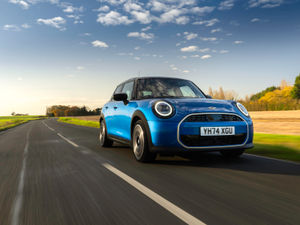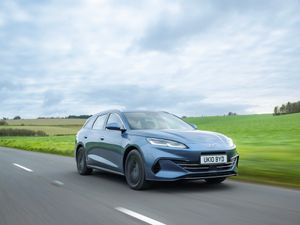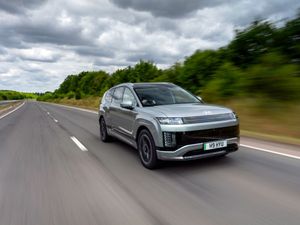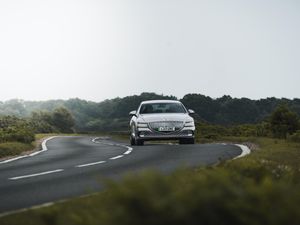Race car for road setting new limits
Honda is celebrating 50 years of sales in Britain and it's been a golden year for the company in many ways.
The icing on the cake was first and third places in the British Touring Car Championship for the popular duo of Gordon Shedden and Wolverhampton's Matt Neal in the new Civic Type-R.
It's a case of just desserts for the engineers, too, who produced a superb handling car which manages to wring a brutal 306bhp out of a mere two-litre capacity engine, setting new limits for a front wheel drive car.
Performance figures of 0 to 62mph in 5.7 seconds and a top speed of 167 mph – combined with superior cornering ability – had already given it the record for the breed on the tough Nurburgring in a time which put it up there with supercars costing three or four times as much.
And that really is another figure to leave you speechless: how Honda manages to sell what is billed as 'a race car for the road' for £30,000, the price of a fairly ordinary family saloon. It's little wonder that not only is there a full order book for the car, but there's a waiting list – with around half those due for Europe being snapped up by British buyers.
You'd expect Honda to produce a good engine: it is the world's biggest manufacturer of engines, powering everything from tiny grass strimmers to Formula One cars.
But conquering the Nurburging is not just about outright power, it's about stability and dynamic handling too with 73 bends in its 12.93 mile length on what is widely regarded as the toughest test in the world. That's how the Type-R won itself a place among the big engined exotica by completing its run in a time of seven minutes, 50.63 seconds.
This breadth of ability is what Honda's engineers were looking for and why enthusiasts had to wait for five years for the car, which is no tweaked version of the family-friendly Civic or an upgraded version of its predecessor.
The engine, for example, combines Honda's thrill-a-minute VTEC variable valve system with a turbocharger for the first time.
Power delivery feels, and sounds, very different. Gone is the sudden surge of acceleration and change in engine note at around 5,500rpm as the VTEC system's second cams and high-lift valve operation comes in and sends you screaming towards the 8,000rpm limit. For the Type R the engineers turned the system on its head, with the high valve lift phase occurring at low to medium revs to eliminate turbo lag and give you more grunt lower down. The result is smooth, accessible power right across the rev range. Now you get all those 306 horses at 6,500rpm, while maximum torque (a huge 400Nm) is there from just 2,500rpm.
In standard mode, the Type-R is still a genuine performer on the roads, a comfortable ride by sportng car standards and decent economy – up to 38.7mpg and a 170g/km CO2 rating.
Press the 'Plus R' button and it becomes a very different beast. The instrument dials glow red, the steering and throttle responses sharpen up dramatically and the suspension gets 30 per cent stiffer.It's a car most buyers will want to take on a track day.
The Type-R has a mixture of mechanical, aerodynamic and electronic features to ensure you can out the power down safety.
Its aerodynamics were developed at the company's Formula One facility, with a shaped underside, new front 'splitter' and rear aerofoil which create a significant amount of downforce – especially at the front to improve steering accuracy.
The adaptive damping system works on all four wheels together or independently. For example under hard acceleration it stiffens up the rear dampers in milliseconds to prevent the front from going light, and vice versa under heavy braking.
Its very effective during extreme cornering too, keeping the car flat and stable for optimum grip and ride comfort. Try hard enough on the track, and especially in the wet, and of course the Type R will still want to move sideways, but it's toned down – more of a warning than creating any nasty oversteer/understeer surprises.
The Type R's natural responsiveness is boosted by a new 'agile handling assist' feature, working in conjunction with the more familiar electronic stability control. In simple terms you get a more rapid steering response and 'turn-in' because it applies a light, imperceptible touch of brake to the inner wheel. Handy on the track, it's a potential lifesaver on the road if, for example, you have to suddenly make a sharp avoidance manoeuvre.
The engineers also developed a new limited slip differential, balanced drive shafts and a unique 'dual axis' design for the front end which work together to improve traction and cut torque steer. It also means you can safely put down more power, and earlier, through a corner.
The Type-R's brakes are huge, 350mm drilled discs supplied by Brembo (who also make brakes for Formula One) which provide impressive stopping power.
Inside you get all the features and practicality you'd expect of the Civic range's flagship, such as satnav, climate control and a sound system with Bluetooth, with added touches such as alloy pedals and gear shift.
Cruise control and a speed limiter (very useful), plus a 'city brake' system are also included in the £29,995 standard Type R package. For anther £2,300 the GT version has an upgraded audio/satnav system and quite a variety of added extras. The insurance group is 33E and the car comes with Honda's three years or 90,000 mile warranty.
It's interesting to note that the first Honda Civic sold here back in 1972 was a classic Mini-sized batchback with an 1,169cc engine. Now there is a whole range of Civic hatchbacks and tourers with the ultra-economical 1.6 diesel among the best sellers.
But there's no shortage of buyers either for what is, undoubtedly, the ultimate front wheel drive performance car at a fraction of the price of some of its exotic rivals.
By John Griffiths





